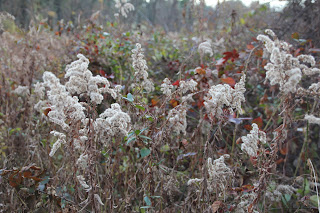Last year, I was invited to serve on an ad hoc advisory committee for a small park in a neighboring municipality. I've posted about this park and my role on the committee before. The park was created when the municipality's old high school was demolished and the grounds dedicated for open space. The high school building was located on a flat plateau at the top of a steep, wooded slope above a creek. The school site, the wooded hillside, and the riparian zone along the creek were all incorporated into the parkland. The mostly-volunteer Friends of High School Park have been working to control invasive non-native plants on the property, which encompasses about 15 acres, and to introduce native species. Until recently, their restoration work was unchallenged by white-tailed deer, but now deer have moved up the stream corridor and "buck rubbing" damage is evident throughout the park.
 |
| A cluster of trees at the edge of the slope in late afternoon light |
 |
| There be dragons in these woods! |
 |
| Another view of one of the landscaped sitting areas |
 |
| Native little bluestem (Schizachyrium scoparium) used ornamentally |
 |
| The grasslands delineated with attractive, low fencing. The yellow trees in the background are all invasive non-native Norway maples (Acer platanoides) |
 |
| Plantings of shrubs and small trees to expand the "edge" out into the grassland |





















































